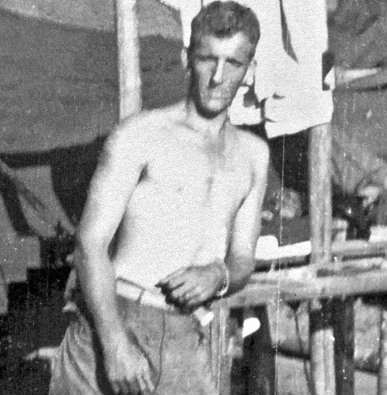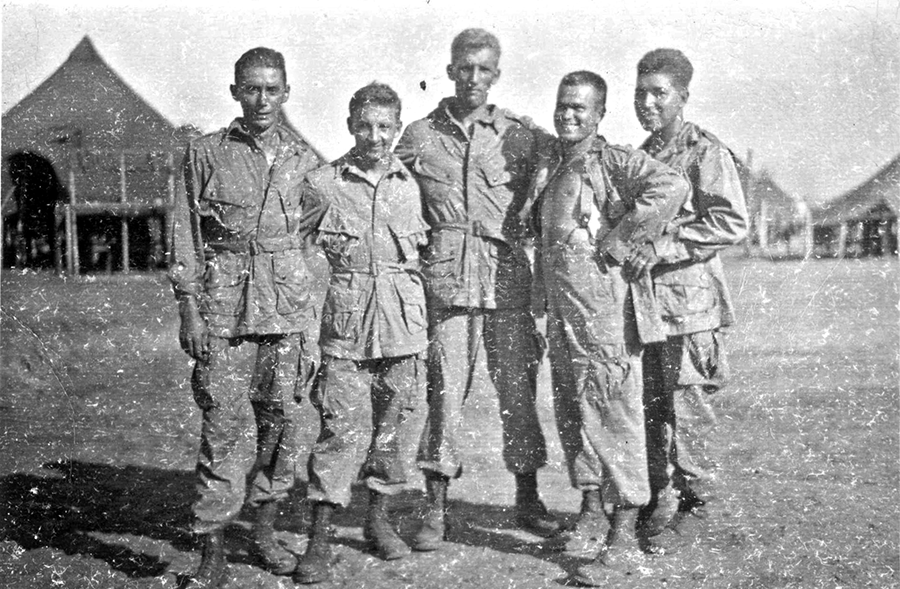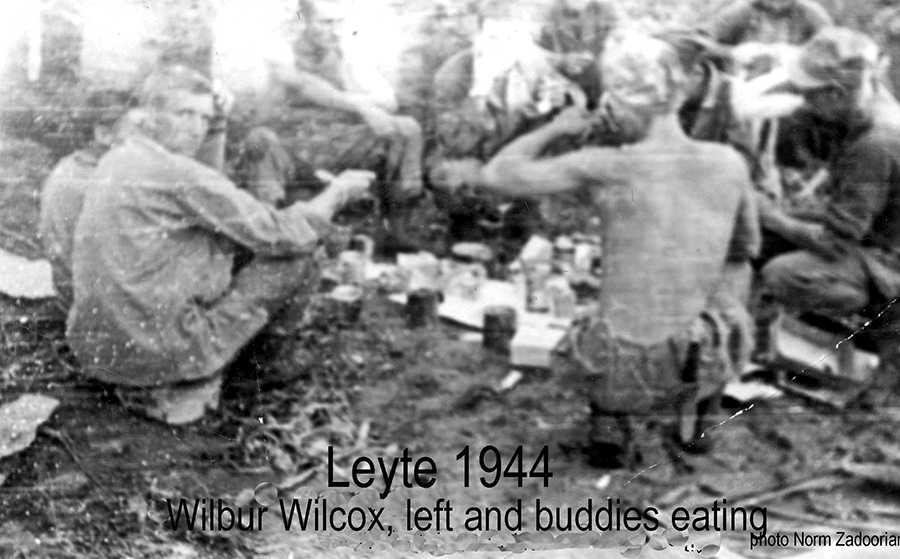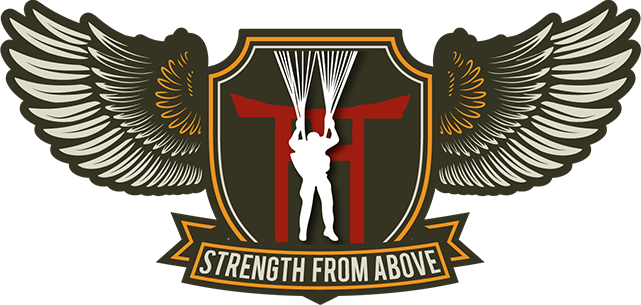S/Sgt. Wilcox, Wilbur

Mail Clerk, Company D, 511th PIR
June 7, 1922, 1922 - May 11, 1995 (Age 86)
Citations: Bronze Star, Purple Heart, Presidential Unit Citation, World War II Victory Medal, Philippine Presidential Unit Citation Badge, Philippine Liberation Medal with service star, the American Defense Medal, and the Asiatic-Pacific Campaign Medal with three Battle Stars and one Arrowhead
Wilbur Lacy Wilcox was born June 7, 1922, in Kansas City, Missouri, the son of Marie and Carl L. Wilson. Wilbur died May 11, 1995 at his home in Warrensburg, Missouri and was buried in Floral Hills Cemetery there.
Wilbur graduated in 1939 from Northeast High School. He joined the Army and became a paratrooper with the 511th Parachute Regiment, serving in Company D.
Wilbur’s training took him through Camp Mackall, North Carolina where he earned his paratrooper badge. In December 1943 he went with the 511th to Cap Polk, Louisiana, undergoing tests, equipment readiness, shots, and everything necessary to prepare him for his upcoming assignments. In May 1944 the Division traveled by troop train to Camp Stoneman, California, which would be the Port of Embarkation for military action in the Philippines. The trip from Camp Stoneman to New Guinea, was to be their staging area, took three tweks by a Liberty Ship, staffed by the Merchant Marines.
Upon landing in New Guinea, the men spent the next five months of jungle training at Oro Bay, Donohura, New Guines. This was in preparation for their first combat assignment.
Wilbur participated in all of the Regiment’s activities, from Jump School, through New Guinea, and the Leyte and Luzon battles. He obtained the rank of Staff Sergeant and was wounded on 13 March 1945 in the battle of Real, Luzon, Philippine Islands. 18 November 1944: After five months of intense jungle training, General Swing and his 11th Airborne Division sailed into Leyte Gulf, landing on Bito Beach.
The following notes are from Wilbur’s private papers donated by his wife, Laurabell:
COMBAT HISTORY D Company 511th Parachute Infantry Regiment Leyte
This Story is in the memory of all combat veterans of D Co, 511th and to Colonel Haugen who was an enlisted man’s officer.
Staff Sgt Wilbur Wilcox
When the 1st and 3rd Battalions moved into the mountains of Leyte, the 2nd Battalion and D Company were left to defend and hold the heights west of Buranen.
C Company and Col. Haugen made first contact with the enemy, an cut off from the remainder of the 1st Battalion, they were left to fight their way out. A Lieutenant and several men from C Company escaped and brought back to the Division Headquarters the rumor that Colonel Haugen had been killed.
The 2nd Battalion was replaced by the 187th and we were sent to aid in the rescue of C Company. On the second day out of Buranen, we ran into Col Haugen who was making his way to Division Headquarters. We were overjoyed to see that our Regimental Commander was still alive. We all jumped into the river and took a bath, including Col. Haugen. This was the last time we would be able to bathe for thirty days. After our baths, we got back on the trail and arrived at Ananong before nightfall.
Our next objective was Mahonag. On December 6, 1944, as we were moving across an open area, one of our men was killed by a ration box. We heard the plane making his run, but it was too late for him to escape. Later that evening, we heard low flying aircraft headed out. As they came over, we thought they were two C 47’s, but I think they were part of the group of planes that dropped the Jap paratroopers. Had we known they were enemy planes, we might have been able to shoot them down or at least cripple them.
The next day, December 7th, we pushed on towards Mahonag. Late in the day, as we were moving down a deep ravine, we saw two Japs digging in a clearing. They were quickly killed and we moved into the area to dig in for the night. This proved to be a big mistake. Almost immediately we started receiving sniper fire. Several men from Headquarters Company were killed. As darkness fell, we could hear the Japs moving around trying to infiltrate our camp. That was the darkest night I can remember! After staying awake all night, we came under a full-scale attack as dawn broke. Machine gun fire cut off the banana trees above our heads. Colonel Shipley quickly ordered a withdrawal. In spite of other information I have read about this episode, we did not counter attack. Instead, Elmer Fryer and his machine gun gave us time to pull out and climb the steep bluff to safety. I think the whole Battalion could have been wiped out. The Japs were on the high ground shooting down our throats. We escaped this trap, and Elmer Fryer was killed as we moved on to Mahonag.
Late in the evening, we found a hillside where the timber had been cut doan and left lying on the ground. Little did we know hot much protection those logs would give us when the planes came over to drop rations. A bouncing ration box was deadly. More than one unsuspecting soldier was killed in this fashion. What was dropped to feed the hungry men could kill them before filling their empty stomachs!
Just outside of Mahonag, astride the Jap supply train an ambust was set up and as the unsuspecting enemy moved along the trail they were slaughtered. One evening the Japs cut the telephone wire between the ambush and Mahonag. Sgt. Ladd and a 2nd Lt from Headquarters Company volunteered to go out and repair it. It was an impossible task to accomplish after dark, and these two brave men lost their lives: They deserve a lot of credit.
The next morning, D Company was sent out to rescue E Company, who were manning the ambush. The Japs climbed trees around the area and began picking off the E Company men in their foxholes. This incident caused E Company to have more casualties than any other Company in the r11th. We knew E Company was desperate, and so we pushed on against heavy resistance. The Japs let the 1st and 2nd Platoons pass and then opened up on the 3rd Platoon. Platoon Sgt. Barrerio, Sgt. Hyatt of the mortar squad and Sgt. Zimmerman, Assistant Squad Leader were killed that day. The Japs threw more grenades that day than any other time I can remember, and we had quite a few casualties from the fragments. Attacking off to the side of the trail, we routed the Japs and reached E Company. I believe they would have been annihilated, if we had been unable to reach them. The bodies of Sgt. Ladd and the 2nd Lt. From Headquarters Company were found in this area. They had not been able to repair the telephone wire. These two men deserve some kind of recognition.
Sgt. Ed Sorensen took over as 3rd Platoon Sgt, and I jumped from Pvt. To Staff Sgt and 3rd Platoon Guide. We kept these ranks until we were discharged.
On December 19, the 2nd Battalion with D Company on point moved down the Supply trail to attack Maloney Hill, from the North. We spent the night on the trail and moved out on the morning of December 20. As we moved along in single file we were startled by the sound of an artillery round going overhead, and looked up to see an artillery spotter plane circling. He had mistakenly identified us as Japs. His first round hit Battalion Headquarters and Capt. Jenkins was killed. Col. Shipley lost a foot and Peter Cutt was mortally wounded, dying the next morning. Several others were woulded and had to return to Mahonag.
D Company moved on with the attack. Just below Maloney Hill we found a large bivouac and hospital area, where the Japs had moved out and left their wounded to die. The wounded were probably from the attacks on Rock Hill and the shelling of Maloney Hill.
As we attacked up the trail to the top of Maloney Hill, we found very few Japs left alive. The artillery had literally torn the hill apart. We moved on up to Rock Hill, where we spent the night. The next morning, December 21, we were told to shave because General Swing was coming through with the 187th. Scraping a month’s growth of beard off was agony!
Elements of the 3rd Battalion had attacked a ridge Southwest of Rock Hill. This ridge was named Hacksaw Ridge after Major Holcom who became 2nd Battalion Commander after Col. Shipley was wounded. After the 3rd Battalion seized Hacksaw Ridte, F Company moved through and attacked down the Jap Supply trail. F Company ran into heavy resistance and heavy casualties as they tried to push out of the mountains to Ormoc…We knew General Swing with the 187th was close behind.
Before dawn on the morning of December 22, 1st Lt. Andy Carrico moved out for attack. This has now become known as the famous Rat’s Ass Attack. Dave Vaughn, whose squad led the attack, coined this phrase. In the dim light, the Japs were caught sleeping and were slaughtered. As the morning got lighter, we sped up the attack. As the trail spread out into the bivouac area, the entire Company became involved. The Japs were not expecting an early morning attack and were surprised. General Swing has claimed that 700 Japs were killed on this last day before breakthrough to the Sea, so who am I to dispute his word. As the fighting slowed down and no more Japs could be found, we were stopped and the 187th with General Swing was allowed to pass through.
This for all practical purposes was the end of the 511th Mountain Campaign.
D Company and elements of the 511th remained in the mountains three more days until all of the wounded were carried out.
The Assault on Manila February 1945 By Staff Sgt Wilbur Wilcox
“Upon arriving on the Island of Mindora, we began getting ready for the jump on Tagaytay Ridge. We received the news on February 2 that we would be jumping the next morning. We moved to the airstrip that evening after drawing out chutes. We moved to the plane we would be using and spent the night under its wings.
“A reporter came around and talked with us, wanting to know what our mission was. Platoon Sgt. Ed Soprensen offered to get him a chute so that he could jump with us and get his information first hand. He declined and left the area.
“Early the morning of February 3rd we loaded up and began the flight to Luzon. D Company was in the lead formation of planes and would be the first to jump. As we came in over Lake Taal, the sun was coming up over the horizon.
“We were told that we might receive anti-aircraft fire from around the Lake. Luckily, we didn’t. As we approached from the South we could see a fog bank on the ridge. The pilot of our plane told Lt. Kannely that he could not see the Drop Zone, but would get us far enough North so that we wouldn’t be flown over the ridge. As we came in over the fog bank, the planes turned East and headed into the sun.
“The Green Light came on; we pushed the bundles out and then Lt. Kannely led us out of the plane. The man in front of the stick landed near the Drop Zone. I was the last man out and landed across the highway from the Manila Hotel Annex. Jumping into a fog bank was worse than jumping at night; we had no idea where we were or what we would hit when we landed.
“We landed safely, and I began looking for D Company men. I found Charles Wise and Red Zadoorian. As the fog began to lift, we saw the Hotel, which we checked out and found empty. At about this time we realized we were the point for the Division.
“We took a position along the highway and decided to wait for the rest of the Company. Suddenly, a movement across the highway caught our eye. Two men were coming out of a grove of trees. As they approached, we saw that one was Capt. Wade of E Company. He knew that we were out in front of the Battalion and decided that we should head back West to contact our D Company. We picked up our equipment and started out. We had not gone very far when we heard a Jeep approaching. It was Division Recon and they were surprised to find us so far out in front. We told them that the Hotel was empty, but they said they wanted to check it out. We continued down the highway for a mile or two and finally ran into the rest of the Battalion. We turned around and headed back to the Hotel, where we spent the night near the highway.
"Third Platoon’s only casualty suffered in the jump was 1st Squad Leader Leonard Klein, who had a broken ankle. Sgt. Royally Streck took over the 1st Squad and led them through the Luzon campaign.
“The next morning, February 4th, the push to Manila began. Colonel Holcom, 2nd Battalion Commander picked D Company to lead the assault. We were loaded into trucks and told to take them until we encountered the Japs. As we headed down the highway the 457th, with their pack howitzers were beginning their jump.
“We drove about 15 or 20 miles and arrived at a bridge that had been blown, which forced us to dismount from the trucks and take a side road, to look for another bridge across the river.
“We approached the town of Imus, and an old Filipino came hobbling down the road to tell us that the Japs were just ahead. We moved cautiously, but swiftly towards a stone wall surrounding a large courtyard. We looked over the wall and saw Japs running around. Maybe they getting ready to pull out and blow up the other bridge across the courtyard. This was the only bridge across the river and we needed it to advance to Manila. The 3rd Platoon moved behind the stone wall and reached a position to protect the bridge. Suddenly, someone opened fire and the fight began! The 1st Platoon’s lead scout, Arthur Chlebove was killed as we moved in. We moved across the open courtyard: There was no cover. Although we had caught the Japs by surprise, a large number of them sought refuge in a large stone building. This was an old Spanish Barracks which the Japanese were using for the storage of their rice and equipment. There were several frame buildings in the area and the Japs had spider holes dug everywhere. We did not have artillery, as some people think we did. The 457th had not had time to get their howitzers up the highway. Finally, they brought up one self-propelled howitzer, and were able to blow up one frame building, but could do nothing to the five foot thick stone walls of the Spanish Barracks. The howitzer was pulled out, leaving the battle to us. Sgt. Tashler, Squal Leader, 2nd Platoon, was killed there.
“We cleaned up all the Japs outside the stone building, but those inside had moved into a small room and blocked all avenues of approach. If we had access to a flame-thrower, something the Division couldn’t furnish, we might have been able to save some of our soldier’s lives.
“Tech Sgt. Bob Steele took matters into his own hands and tossed a phosphorous grenade through the roof of the building. For his action, Sgt Steele received the Distinguished Service Cross. He was killed February 8 in Southern Manila.
Records show that Sgt. Steele, under covering fire from his Platoon, advanced to the warehouse under fire, climbed to the roof and tore a hold through. He then poured gasoline through the roof, ignited it and the enemy with a phosphorous hand grenade. When the enemy rushed out, the 2nd Platoon mowed them down. Steel died in the battle of Manila a few days later, February 8, 1945, and was awarded, posthumously, the Distinguished Service Cross.
“With the enemy contained, D Company headed out on foot for Manila some ten miles away. We left part of the 2nd Platoon to protect the bridge. The rest of the Company headed out. We arrived at Paranaque River bridge and came under heavy firs. As night was falling, we laid down beside the road: The ending of a day where we had advanced some thirty miles. It was dark as pitch. I was lying with my rifle between two buildings, listening for any Jap movement. I heard my name called. It was Lieutenant Walt Kannely. He wanted John Bittorie and I to go with him back to Imus. At least we were riding this time. John got on the hood of the Jeep with his BAR and rode shotgun. We knew the Japs were all around us, and we expected anything could happen. We made the ten-mile trip without incident. This took a lot of guts from John Bittorie, but that was something he was never short of.
“This day, February 4, 1945 was crammed full of action for D Company, 511th Parachute Infantry.”
A few days later, February 13, 1945, Wilbur was wounded in the battle of Real, Luzon, Philippine Islands. He was one of nineteen men from D Company who was wounded that day.
Wilbur recovered from his injuries and went to Japan with the American Occupation forces, and was in General Swing’s Honor Guard which greeted General MacArthur upon his arrival in Japan to sign the peace treaty.
A copy of an Extract from General Orders 55, dated 27 March 1945 follows:
Headquarters
11th Airborne Division
APO 468
GENERAL ORDERS
27 March 1945
Number 55
…..
Section II - Bronze Star Awards
…..
Bronze Star Medal
Staff Sergeant Wilbur Wilcox, 372293972, Infantry, United States Army. For heroic achievement in connection with military operations against the enemy on Luzon, Philippine Islands on 11 February 1945. During an engagement with the enemy, the platoon of which Staff Sergeant Wilcox was a member was ordered to withdraw to a more advantageous position. Although he was wounded, Staff Sergeant Wilcox remained forward and covered the withdrawal of the platoon. Such a display of courage and loyalty is in keeping with the finest traditions of the Armed Forces. Home address: Mr. Carl A. Wilcox, (father), 110 South Evanston Street, Kansas City, Missouri.
BY COMMAND OFMAJOR GENERAL SWING
After his service in the military, Wilbur returned home and married Laurabell Puckett on 3 June 1950. Wilbur kept in touch with his fellow-troopers through reunions and letters, and his knowledge of the workings of their outfit was truly amazing. He collected old war photographs, and sat by his fireside on many a cold winter evening, going over them and recalling incidents for any guests who happened to drop by.
Wilbur is survived by his wife, Laurabell, a sister, and a stepdaughter.
SOURCE:
Wilbur’s papers, pictures and notes (courtesy of Laurabell Wilcox)
Handwritten notes of Wilbur Wilcox “Assault on Manila” (courtesy of Emily & Roy Streck)
Recollections of Andy Carrico, Platoon Leader
Obituary
Typed by Jane Carrico Nov 2004
PUBLISHED IN WINDS ALOFT Winter 2007
 Willbur Wilcox is standing in the center (Photo by Red Zadoorian via Jane Carrico) |
 Wilbur Wilcox, seated on left, eating K-Rations with squadmates on Leyte (photo by Red Zadoorian, courtesy of Jane Carrico) |
If you would like to learn more about Wilbur's exploits within and the history of the 511th Parachute Infantry Regiment in World War II, please consider purchasing a copy of the book WHEN ANGEL'S FALL: FROM TOCCOA TO TOKYO, THE 511TH PARACHUTE INFANTRY REGIMENT IN WORLD WAR II, available in the regimental online store, on Amazon or wherever military history books are sold.
